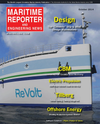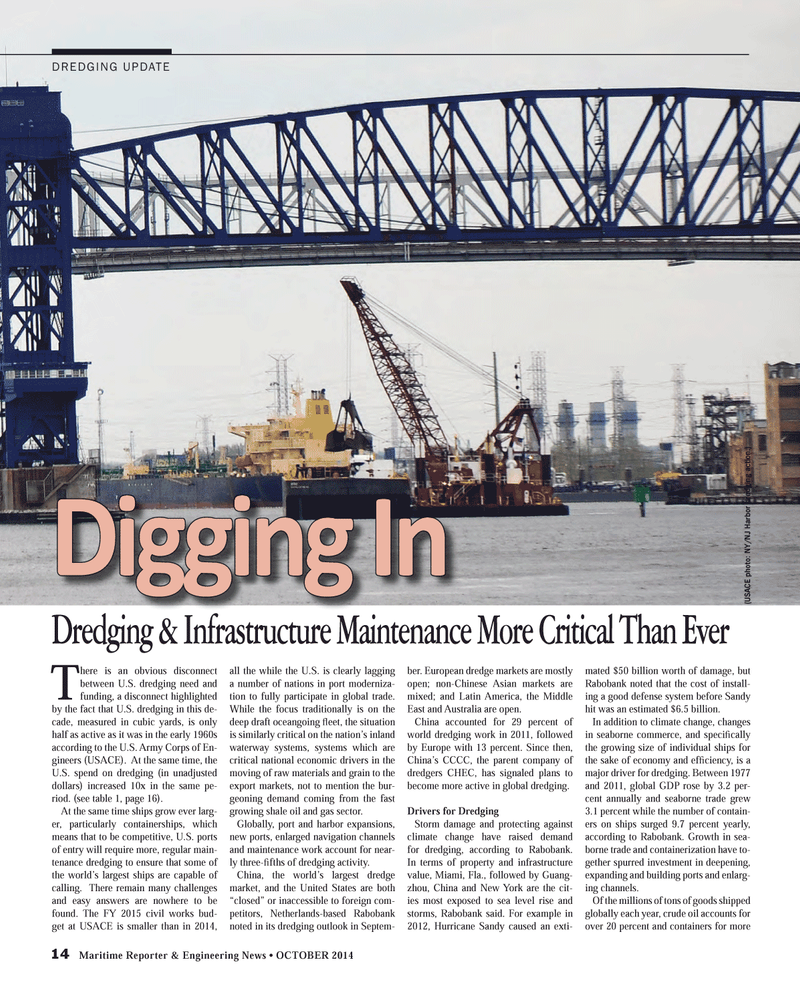
Page 14: of Maritime Reporter Magazine (October 2014)
Marine Design Edition
Read this page in Pdf, Flash or Html5 edition of October 2014 Maritime Reporter Magazine
14 Maritime Reporter & Engineering News • OCTOBER 2014
DREDGING UPDATE
T here is an obvious disconnect between U.S. dredging need and funding, a disconnect highlighted by the fact that U.S. dredging in this de- cade, measured in cubic yards, is only half as active as it was in the early 1960s according to the U.S. Army Corps of En- gineers (USACE). At the same time, the
U.S. spend on dredging (in unadjusted dollars) increased 10x in the same pe- riod. (see table 1, page 16). At the same time ships grow ever larg- er, particularly containerships, which means that to be competitive, U.S. ports of entry will require more, regular main- tenance dredging to ensure that some of the world’s largest ships are capable of calling. There remain many challenges and easy answers are nowhere to be found. The FY 2015 civil works bud- get at USACE is smaller than in 2014, all the while the U.S. is clearly lagging a number of nations in port moderniza- tion to fully participate in global trade.
While the focus traditionally is on the deep draft oceangoing fl eet, the situation is similarly critical on the nation’s inland waterway systems, systems which are critical national economic drivers in the moving of raw materials and grain to the export markets, not to mention the bur- geoning demand coming from the fast growing shale oil and gas sector.
Globally, port and harbor expansions, new ports, enlarged navigation channels and maintenance work account for near- ly three-fi fths of dredging activity.
China, the world’s largest dredge market, and the United States are both “closed” or inaccessible to foreign com- petitors, Netherlands-based Rabobank noted in its dredging outlook in Septem- ber. European dredge markets are mostly open; non-Chinese Asian markets are mixed; and Latin America, the Middle
East and Australia are open.
China accounted for 29 percent of world dredging work in 2011, followed by Europe with 13 percent. Since then,
China’s CCCC, the parent company of dredgers CHEC, has signaled plans to become more active in global dredging.
Drivers for Dredging
Storm damage and protecting against climate change have raised demand for dredging, according to Rabobank.
In terms of property and infrastructure value, Miami, Fla., followed by Guang- zhou, China and New York are the cit- ies most exposed to sea level rise and storms, Rabobank said. For example in 2012, Hurricane Sandy caused an exti- mated $50 billion worth of damage, but
Rabobank noted that the cost of install- ing a good defense system before Sandy hit was an estimated $6.5 billion.
In addition to climate change, changes in seaborne commerce, and specifi cally the growing size of individual ships for the sake of economy and effi ciency, is a major driver for dredging. Between 1977 and 2011, global GDP rose by 3.2 per- cent annually and seaborne trade grew 3.1 percent while the number of contain- ers on ships surged 9.7 percent yearly, according to Rabobank. Growth in sea- borne trade and containerization have to- gether spurred investment in deepening, expanding and building ports and enlarg- ing channels.
Of the millions of tons of goods shipped globally each year, crude oil accounts for over 20 percent and containers for more (USACE photo: NY/NJ Harbor dr edging action.)
Dredging & Infrastructure Maintenance More Critical Than Ever
Digging InDigging In
MR #10 (10-17).indd 14 10/6/2014 11:18:07 AM

 13
13

 15
15
